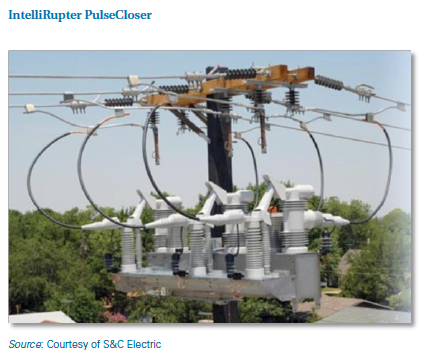Pulse Reclosing
Risk Reduction Category
Technology Description
Faults on distribution circuits are often momentary in nature.
High-current faults (low-impedance) happen when energized conductors make contact or insulation flashes over. Several examples of high current faults include:
- Tree limb bridging phase-to-phase or phase-to-neutral
- Balloon, animal, or another external object
- Conductor slap
- Equipment failure
These are the most common type of fault on distribution systems, and protection equipment (circuit breakers, fuses, and reclosers) are designed to protect the system when these faults occur. In a high-current fault, the main ignition risk is burning sparks created by a high-current arc. If vegetation or flammable materials such as oil or polymer animal guards are ignited by an arc, these can increase risks of wildfire ignition[1].
Strategically located on distribution feeders, traditional line reclosers operate similar to substation circuit. A new type of reclosing device has been developed by S&C Electric called a PulseCloser®. This device is functionally similar to a recloser in that the device trips to isolate fault current [2]. After clearing a fault, however, the IntelliRupter® tests for continued presence of the fault. “IntelliRupter intelligently closes at a precise point on the voltage wave, resulting in a short pulse that’s less than half the symmetrical fault current. The key difference is that the pulse closing technology recloses very quickly and for a short duration to limit the amount of energy supplied to the fault. Like a recloser, if the fault is still present the switch will ultimately lock out”[3]. A photo of an IntelliRupter is shown from [2].

While often applied in an effort to reduce voltage sags, the IntelliRupter also reduces the amount of energy supplied to the fault, as previously noted. This can result in the reduction of potential fire incidents due to faults and reclosing. S&C indicates that using PulseClosing Technology, the IntelliRupter fault interrupter uses 95% less energy to test for faults[4].
Technical Readiness (Commercial Availability)
This product is unique to S&C Electric. The IntelliRupter has been installed at a number of utilities around the world since early 2010s.
S&C Electric
https://www.sandc.com/en/products--services/products/intellirupter-pulsecloser-fault-interrupter
Implementations / Deployments
The IntelliRupter has been installed at a number of utilities around the world since the early 2010s
Innovations as of Mid 2023
For a utility in Australia, upgraded firmware/logic has been applied to work with high-impedance low fault current situations[5].
References
[1] Ignition Scenarios and Solution Options, Technical Brief: Distribution Systems, Tom Short, EPRI 3002025027, Palo Alto, CA, June 2022.
[2] PQ TechWatch: Minimizing Voltage Sags Due to Distribution Faults by Limiting Fault Current Magnitudes, EPRI, Palo Alto, CA, October 2014.
[3] S&C Electric Company, “S&C IntelliRupter ® PulseCloser: Outdoor Distribution, 15.5 kV through 38 kV,” December 2, 2013, www.sandc.com/edocs_pdfs/EDOC_036231.pdf.
[4] S&C Electric Company, “The Difference Pulse Closing Technology”, https://www.sandc.com/en/products--services/products/intellirupter-pulsecloser-fault-interrupter/#TheDifferencePulseClosingTechnology, January 3, 2024.
[5] S&C Electric Company, “IntelliRupter® PulseCloser® Fault Interrupter Algorithm Enhances Bushfire- Mitigation Strategy”, 11/18/2019, retrieved from page listed in reference [4], January 3, 2024.